Yellow is a possible theme this week. Yellow pine pollen, yellow puncture vine, yellow mustard, all can be easily seen now.

Pine is pollenating now. Photo by Brian Maudsley.
Pine trees are growing tan male pine cones now, (microsporangiate strobili) which are edible but taste like a dry sponge. When tapped they release a yellow dust. That dust is pollen and has been used for centuries as a testosterone supplement. Ten grams of pine pollen has approximately 0.8 micrograms of testosterone. Eating the male pine cones does not deliver the dose. The pollen has to be placed under tongue. I know people who collect pine pollen every year. It is high in protein and can be used to extend flour. Digesting pollen does not have a hormonal effect. Pine pollen has often been blamed for allergies to ragweed (also yellow) However, in comparison pine pollen is heavy and does not drift as easily or as far as ragweed pollen so amny folks who think they have a pine allergy have a ragweed allergy. Incidentally Female pine cones are MACROsporangiate strobili.

(Tribulus terrestris) on the beach
The yellow puncture vine tribulus trestris, has yellow blossom and a long history in folk medicine for treating male sex issues, often attributed into its ability to increase nitric oxide levels (as does Dollar Weed.) Complicating usage is where the puncture vine was grown (country.) That seems to affect efficacy of the plant. To extend the yellow theme, wild mustard’s yellow blossoms are common now in long rows along dry roadways. Very conspicuous. There are no hormonal uses. However, it has many culinary issues from a pot herb to a fermented food.
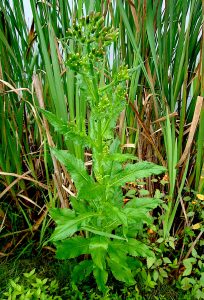
Burnweed/Fireweed in blossom in front of cattails. Photo by Green Deane
Fireweed/Burnweed has a flavor chefs love. With an impossible scientific name and strong aroma Fireweed (Erechtites hieraciifolius) is often over looked by the foraging community. Conversely the aroma is also a good identifying characteristic. As with several things in life tastes vary and many people enjoy the Fireweed raw or cooked. Closely related to the Dandelion, the Fireweed locally favors the late winter or early spring. Currently you can find Fireweed from a few inches high to a couple of feet. While they do not grow in colonies often several will grow near each other. Soon the older ones will put on green-yellow blossoms that barely open, another identifying characteristic. Of course in greens young and tender is usually preferable and this is particularly true with the Fireweed which grows rank as it ages. To read about fireweed go here.
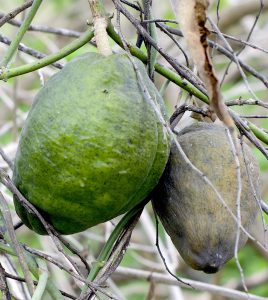
Fruit of the Latex Strangler Vine. Photo by Green Deane
Another recent find was Latex Strangler Vine. At one time a bane of the citrus industry the lengthy vine grows edible fruit that is high in vitamin C. It’s called “Strangler” because it can cover a citrus tree shading it out and killing it. The species was “found” twice in Florida some twenty-five years apart in the last century. The state unsuccessfully spent millions trying to get rid of it Look for it on fences and around current or old citrus groves. Decades ago when the weather was warmer the vine was common wherever there was citrus. Cooler weather has frozen it and citrus out on the north end of the state. I have seen Latex Strangler Vine in Ocala and near Gainesville but that’s the limit. In both cases the plants were under Live Oaks and in unmowed areas. It is quite common mid-state and south. The blossoms are edible off the vine. The raw leaves can also be eaten but are usually dipped in oil first. My article on the species is here. I also have a video on the species here.
Foraging classes: This week span the coasts from John Chestnut Park in New Port Richey to Wickham park in Melbourne.
Saturday February 25th, John Chestnut County Park: 2200 East Lake Road, Palm Harbor, FL 34685. Meet at the trail head of the Peggy Park Nature Walk, pavilion 1 parking lot. 9 a.m
Sunday February 26th, Wickham Park: 2500 Parkway Drive, Melbourne, FL 32935-2335. Meet at the “dog park” inside the park 9 a.m.
Saturday March 4th, Red Bug Slough, 5200 S. Beneva Road, Sarasota, 9 a.m.
Sunday march 5th, Mead Garden: 1500 S. Denning Dr., Winter Park, FL 32789. Meet at the bathrooms, 9 a.m.
For more information, to pre-pay or sign up, go here.
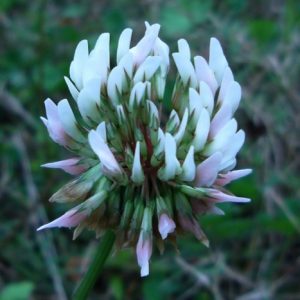
White clover blossoms is often used for tea. Photo by Green Deane
Clover is one of those wild edibles that is both overstated and understated. The overstatement is from writers who offer it as a great human food full of this and that to keep us healthy. The understated part is that it can harbor a fungus that inhibits clotting and somewhere around a half-a-cup of raw leaves can make you throw up. Individual experience, of course, can vary and there are several different species of clover with different characteristics. Pictured here is a nice little White Clover which is blossoming now mostly in lawns and athletic fields. A few leaves can be eaten raw. They are high in protein for a leaf. The blossom fresh or quickly dried can be used for tea. There is also Crimson, Red, Sweet and even Tick Clover.
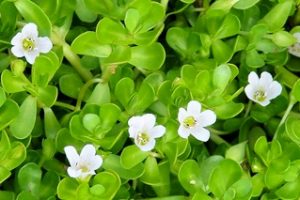
Bacopa monnieri can have four or five petals.
Before I forget it’s time to write about Bacopa again. Actually there are six Bacopas locally, two common: Water Hyssop and Lemon Bacopa. They are quite different and perhaps it takes a trained botanical eye to appreciate their similarities which strike me as few. Perhaps their greatest difference is texture. Lemon Bacopa is soft, fuzzy, and crushes easily. It smells like limes not lemons. Water Hyssop is tough and shiny, resilient. Lemon Bacopa is aromatic and fruity in flavor, Water Hyssop is just pain bitter. Water Hyssop definitely can help with memory issues, Lemon Bacopa is more iffy on that score. One does not find Lemon Bacopa too often whereas Water Hyssop is nearly everywhere the soil is wet and sunny. (There are actually five Bacopas that look like the bitter one we want but four of them are rare. The one we want, Bacopa monnieri, by far the most common, has a single crease on the middle of the leaf.) I have found Lemon Bacopa only three times; two of them in the wet ruts of woods roads. There is also a lake near me that has a little growing near a boat ramp when the water level is just right. As my article speaks more towards Lemon Bacopa I will adress Water Hyssop here. It basically stimulates the brain to make new neuronal connections, specifically in the hippocampus. It is anti-inflammatory and interacts with the dopamine and serotenergic systems. As you might expect growing new memory cells enough to notice takes time. So Bacopa has to be taken daily for at least three months. I have had several people tell me it has made significant difference in their lives. It does not work on all causes of memory problems but if it does work it does so dramatically. You can read about both Bacopas here.
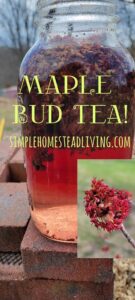
Maple buds. Photo by Simplehomesteadliving. com
This time of year a forested horizon locally will have a red hue. That is caused by budding red maples, Acer rubrum. While the winged maple seeds are edible they can be bitter with tanins. However, that makes the buds and later seeds good candidates for tea. Use them like making sun tea, that is, put them in a large jar and let them soak. You should know dry red maples leaves and bark are toxic to horses. Fresh leaves are not. Dry leaves are also toxic to llamas or alpacas. Toxic chemicals in the dry leaves include gallic and tannic acid, which destroy a horse’s red blood cells. Another toxin pyrogallol, prevents red blood cells from being able to carry oxygen. Three pounds of leaves, a small amount for a horse, is enough to kill them. Red-brown urine tells you the horse is suffering from the toxins. Effectively, there isn’t any treatment.
If you’re a gardener: The Florida keys are usually hard limestone islands. West of Miami the soil is only about a foot thick sitting on feet of limstone. The way they grew food on key west was to mix horse manure with sea weed to create soil.

You get the USB, not the key.
My nine-DVD set of 135 videos has been phased out and replaced by 171-videos on a 128-GB USB, see right. The USB videos are the same videos I have on You Tube. Some people like to have their own copy especially if social order falters. The USB videos have to be copied to your computer to play. If you want to order the USB go to the DVD/USB order button on the top right of this page or click here. That will take you to an order form. Or you can make a $99 donation, which tells me it is for the USB (include a snail-mail address.) I’d like to thank all of you who ordered the DVD set over the years which required me to burn over 5,000 DVDs individually. I had to stop making them as few programs now will read the ISO files to copy them. Burning a set also took about three hours.

Green Deane Forum
Want to identify a plant? Perhaps you’re looking for a foraging reference? You might have a UFO, an Unidentified Flowering Object, you want identified. On the Green Deane Forum we — including Green Deane and others from around the world — chat about foraging all year. And it’s not just about warm-weather plants or just North American flora. Many nations share common weeds so there’s a lot to talk about. There’s also more than weeds. The reference section has information for foraging around the world. There are also articles on food preservation, and forgotten skills from making bows to fermenting food. Recent topics include: Stale Bread and Cod Liver Oil, Killing Bugs with Tobacco Plugs, Eating weeds: Is it safe? Have they mutated? Not the Eastern Red Bug but the Pink Tabebuia, African Tulip Tree, Asparagus densiflorus, Green Deane’s Book… You can join the forum by clicking on the button on the upper right hand side of this page.
This is my weekly newsletter #546. If you want to subscribe to this free newsletter you can find the sign-up form in the menu at the top of the page. My website, EatTheWeeds.com, which is data secure, has over 1500 plants on it in some 428 articles. I wrote every one myself, no cut and paste.
To donate to the Green Deane Newsletter click here.

